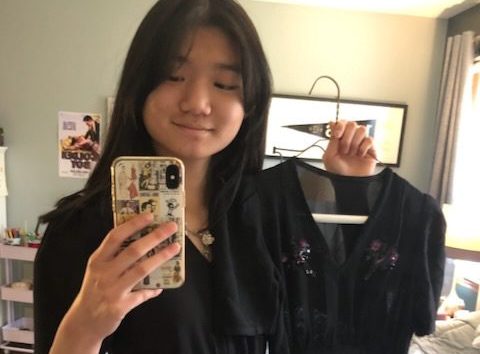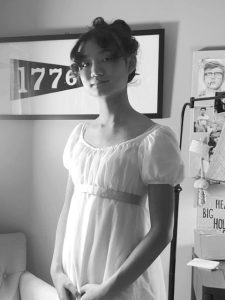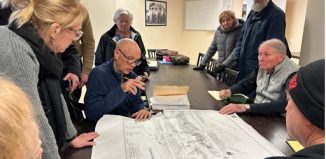Smithtown’s Avery Yang wins $40K Judge Cohalan history scholarship

By Daniel Dunaief
For her in-depth research about the Prime Thimble Factory in Huntington, Smithtown High School East senior Avery Yang has won the Honorable Peter Fox Cohalan Scholarship in American Studies from the Robert David Lion Gardiner Foundation.
In its 10th year, the scholarship provides $10,000 per year for four years to a student who plans to study history in college and who demonstrates a commitment and interest in the subject by focusing on an element of local history on Long Island that reflects New York state and American history.

An accomplished student at Smithtown High School East, Yang focused on the factory that produced the small metal pieces that protected the fingers of those who were sewing from 1836 until the 1880’s.
“She did a great job on her research,” said Judge Cohalan, for whom the scholarship is named and who is one of the four trustees of the foundation. “Her English was perfect, there were no mistakes. I’m a nitpicker.”
Yang, who plans to attend the University of Massachusetts at Amherst in the fall, is especially passionate about the history of fashion and its connection to the cultural history of an era.
In her paper, which included 30 references and 47 endnotes, including a photo from her own collection of thimbles, Yang described not only the history of the factory but also the symbolism associated with the thimble.
To continue to receive the scholarship, whose previous winners have attended schools including William & Mary, Dartmouth, the University of Michigan and Marist, Yang must earn a 3.25 grade point average during each semester and contribute to a local historical society through a host of possible eligible activities, including website design and maintenance general research.
Over the course of its operation, the factory, which was owned and operated by Ezra Prime, “reflected changes and conflicts within American society. It echoed the broader shift across industries from artisans to factories, and shaped social debates surrounding women’s rights through its product’s symbolic meaning,” wrote in her winning essay.
Gibson girls
Shaun Minton, who taught Yang last year in an Advanced Placement US History class, was delighted that she won this scholarship.
He described Yang as the “top of the top” among students.
During class last year, Minton was discussing the flapper style of the 1920’s. He usually compares the flappers to the Gibson Girl.
While some students may have heard of, read about or seen films with flappers, few have any working knowledge of the Gibson Girl, whose archetypal fashion preceded the flappers.
That, however, wasn’t the case for Yang, who was able to “explain the fashion of the Gibson Girls better than I could.”
In an email, Yang described the Gibson Girl, who was described in illustrations by Charles Gibson, as fashionable women who were modern and active and yet conformed to a patriarchal view of femininity.
Minton, who provided a college recommendation for his former student, recalled how she wrote a targeted and accurate response to a document based question.
“She was able to get right to the point and analyze the material in such a concise manner that I photocopied her paper and showed it to the rest of the class,” he said.
Fashion and history
Yang became fascinated with understanding history through fashion in middle school, when she started watching videos on the Internet of people who made historical clothing.
“The tactile aspect drew me into it,” she said.
To live the connection to history, Yang sews her own clothing that reflects the styles and fashions of the time. She recreated a vintage original dress that took about three weeks to make from the 1930’s and early 1940’s with rayon crepe that she bought from an online fabric store.
For another ensemble from around 1818, she worked for about two months to recreate a gown from Théodore Géricault’s “Portrait of Laure Bro.” She researched primary sources such as historical sewing guides and garments in digital museum collections.
She enjoys the connection to the people, history and culture when she designs and sews these outfits.
It is a “magical experience to feel like you are participating in the same sorts of practices and rituals as someone from the past,” she said. “When I finally get to put it on, it’s a completely surreal experience.”
Yang has her own Youtube channel and her videos, which include descriptions of old antique machines and the dresses she’s made with them as well as a description of sock plushies.
Yang’s parents Alan and Cherry Yang are happy and proud of the work her daughter, who has also been a Gardiner scholar, did for this scholarship, which is an ongoing part of her passion for history.
Yang surrounds herself with history, as her room has various antiques including a collection of working children’s sewing machines, old irons, advertising pieces and spools of thread, said her mother.
Yang loves antique shops, where “each object there has a story. We bring items home” and her daughter delves into its history, her mother said.
Minton appreciates how Yang, who is successful in math and science classes as well, has chosen to study history in college.
“Kids of her caliber nowadays tend to do STEM,” he said.
Yang’s parents would like their daughter and her older siblings to find their own way. After college, Yang, who also plays alto saxophone in several groups including the pit orchestra and jazz band, would like to go into museum conservation where she can work with historical pieces and help preserve them, giving her the opportunity to paint a picture of cultural and social trends that are often missing from the written record. She would also consider becoming a history teacher.
Yang, who is hoping to participate in the graduate level program in public history at UMass Amherst, sees fashion as a reflection of cultural and social aspects of life.
“I find it really interesting to see changes in fashion and the ways in which things are sewn,” she said.






